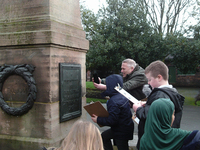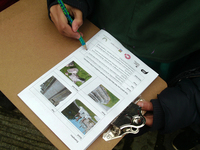- County name: Staffordshire
- Group/School name: Summerbank Primary Academy
- Age group: 5 - 11
- Group type: Year 4
Following training delivered by the Heritage Schools Local Heritage Education Manager for the West Midlands, the opportunity arose for War Memorial Trust’s Learning Officer to deliver a school visit in the Stoke area. The year 4 teacher at Summerbank Primary Academy was keen for his class to learn more about the impact and significance of World War I on the local population of Tunstall and a visit to the school was arranged. During the day it was planned that pupils would carry out a condition survey for Tunstall war memorial and also research local men who are commemorated by the monument.
The day begin with a series of activities in the classroom which would help develop the pupils understanding of what war memorials are, why they were created and when. Pupils were asked to identify what a war memorial is. Discussions ensued and it was established that they could be any object (pillars, crosses, buildings, windows, statues) which remember those people who fought in wars. Many of the pupils associated war memorials with the First and Second World War and it was highlighted that although many do commemorate these conflicts, they also remember those who fought in other conflicts as well. To reinforce the different types and designs of war memorials, a selection of local ones were shared. These included a lectern, a clock and a street shrine which was originally unveiled on the outside of a pub.
Pupils were asked to consider how many war memorials there are in the UK from a selection of numbers (100, 1,000, 10,000, 100,000 and 1,000,000). A range of answers were given but the most popular was 10,000. As a result the pupils were shocked to learn that there are about 100,000 war memorials in the UK. Pupils were then shown a simple timeline to help explain when war memorials were created. The timeline also provided the opportunity to highlight that this year and upcoming years will see the 100th anniversary of when many of these war memorials were unveiled.
Having looked at what, how many and when, pupils were then asked to consider why war memorials were created particularly following the First World War. It was quickly established that they were to make sure that future generations (including the pupils themselves) remembered those who had made the ultimate sacrifice. Through further discussion it was established that the fallen were buried near where they died on the battlefields and as such families did not have a grave locally that they could visit. Two men from Tunstall were used as examples to highlight where the fallen were buried (Greece and Egypt) and to help explain that it was unlikely that families would be able to travel to these countries to visit the cemetery where they were buried.
The second half of the morning session took the pupils out of the classroom and to the memorial gardens in Tunstall where the memorial obelisk is located. Pupils looked at and described the memorial before carrying out a condition survey. Some of the observations pupils made were that the inscriptions incised into the stone were fading, particularly the number 4 in the year 1945. They also noticed some moss growth on the stone and a little weathering and erosion. In 2009 a memorial wall was erected in the gardens. The obelisk does not have any names on and local people felt it was important that the names of the fallen from all conflicts were remembered. Pupils had the opportunity to look at these names. The number of those who lost their lives in World War I was quite astonishing for a relatively small place like Tunstall. A Conservation Officer for Stoke-on-Trent also attended the visit to the memorial garden while pupils were carrying out the condition survey. He was able to tell the pupils more about how the gardens are looked after and the addition of names to the memorial wall.
The afternoon began with pupils uploading the condition survey to War Memorials Online. Each of the three expert groups had given the aspect of the memorial they were focusing on a condition level of Fair and as a result they gave the memorial an overall level of Fair. They noted the concerns they had and observations made in the comments box so that there is a good record of the current condition of the memorial.
During the remainder of the afternoon, pupils were shown how they could find out more about the men remembered by the obelisk and named on the memorial wall. To do this they used the ‘Find War Dead’ database on the Commonwealth War Graves Commission website. To ensure the children were successful in their search they selected the men they wanted to research from a list of eleven names. Each name had 1, 2 or 3 stars next to it to indicate the level of difficulty and amount of perseverance required. Some pupils began with an easy search and then chose to challenge themselves further with a more difficult second search.
At the end of the afternoon, pupils were able to share some of the information they had found out about the men. One of the pupils shared that the soldier they had been finding out about died aged 19 which they felt was incredibly young. WMT’s Learning Officer then showed the pupils a map of Tunstall which had the school marked on as well as the houses where the eleven men the pupils were researching lived. It was clear that when these men did not return from the First World War it would have had a big impact on the community. From the eleven men selected, there were two streets which each had 2 of the men living there and one where three of the men had lived.
Working with the year 4 pupils and seeing them develop their understanding of war memorials and the impact that the First World War had on the local area as the day progress was a real pleasure. Hopefully they will continue to remember those from Tunstall who made the ultimate sacrifice and show an interest in protecting their local war memorial for years to come.





